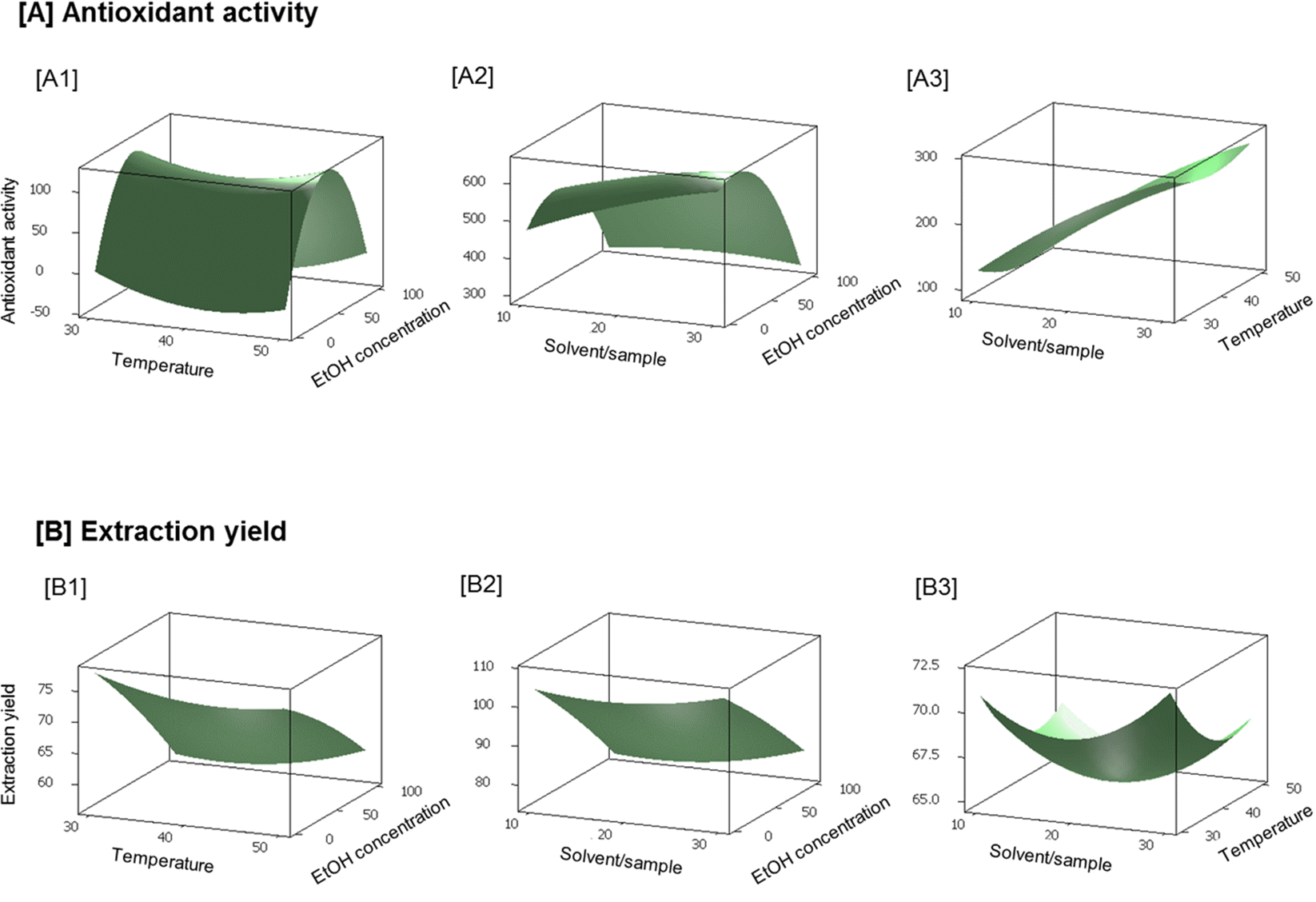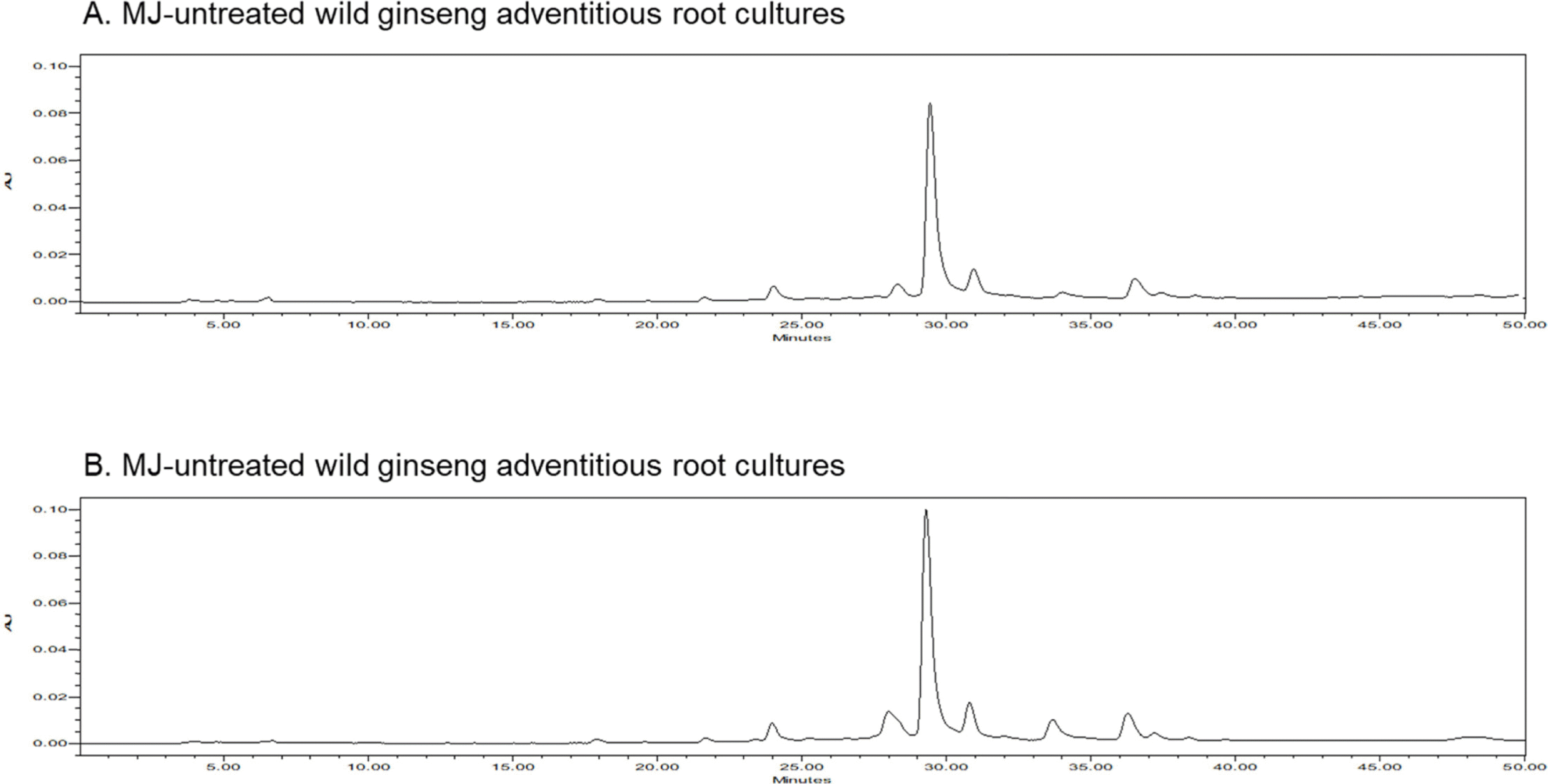Abstract
The usage of wild ginseng (Panax ginseng C.A. Meyer) has been limited due to short supply and high price. Therefore, sufficient production as well as efficient extraction of mountain ginseng are required for the development as products. In this study, wild ginseng adventitious root cultures were prepared for efficient production with advantages of fast growth and stable production. Treatment of methyl jasmonate (MJ) to wild ginseng adventitious root cultures increased the extraction yield and antioxidative activity. Further investigation on effect of extraction conditions suggested the importance of ethanol concentration on antioxidative activity and extraction yield of MJ-treated wild ginseng adventitious root cultures. Optimized extraction condition of MJ-treated wild ginseng adventitious root cultures for maximum extraction yield and antioxidative activity was determined using response surface methodology with three-level-three-factor Box-Behnken design (BBD). Extraction of 1 g MJ-treated wild ginseng adventitious root culture with 30 ml of 9% ethanol at 30oC produced 310.2 mg extract with 71.0% antioxidative activity at 100 µg/ml. Taken together, MJ-treated wild ginseng adventitious root culture is valuable source for wild ginseng usage and optimized extraction condition can be used for the development of functional products or folk remedies.
References
(1). Chung I. M.., Lim J. J.., Ahn M. S.., Jeong H. N.., An T. J.., Kim S. H. J.Ginseng Res. 2016. 40:68–75.
(2). He J. M.., Zhang Y. Z.., Luo J. P.., Zhang W. J.., Mu Q.Nat. Prod. Commun. 2016. 11:739–740.
(3). Herzi N.., Bouajila J.., Camy S.., Romdhane M.., Condoret J. S.Food Chem. 2013. 141:3537–3545.
(4). Hu F. X.., Zhong J. J. J.Biosci. Bioeng. 2007. 104:513–516.
(5). Jeong G. T.., Park D. H.., Ryu H. W.., Hwang B.., Woo J. C.., Kim D.., Kim S. W.Appl. Biochem. Biotechnol. 2005. 124:1147–1157.
(6). Jeong J.Y.., Jo Y. H.., Lee K. Y.., Do S. G.., Hwang B. Y.., Lee M. K.Bioorg. Med. Chem. Lett. 2014. 24:2329–2333.
(7). Kim O. T.., Bang K. H.., Shin Y. S.., Lee M. J.., Jung S. J.., Hyun D. Y.., Kim Y. C.., Seong N. S.., Cha S. W.., Hwang B.Plant Cell Rep. 2007. 26:1941–1949.
(8). Murthy H. N.., Georgiev M. I.., Kim Y. S.., Jeong C. S.., Kim S. J.., Park S. Y.., Paek K. Y.Appl. Microbiol. Biotechnol. 2014. 98:6243–6254.
(9). Pan H. Y.., Qu Y.., Zhang J. K.., Kang T. G.., Dou D. Q. J.Ginseng Res. 2013. 37:355–360.
(10). Park J. G.., Son Y. J.., Aravinthan A.., Kim J. H.., Cho J. Y. J.Ginseng Res. 2016. 40:431–436.
(11). Patel S.., Rauf A.Biomed. Pharmacother. 2017. 85:120–127.
(12). Rahimi S.., Kim Y. J.., Yang D. C.Appl. Microbiol. Biotechnol. 2015. 99:6987–6996.
(13). Ru W.., Wang D.., Xu Y.., He X.., Sun Y. E.., Qian L.., Zhou X.., Qin Y.Drug Discov. Ther. 2015. 9:23–32.
(14). Ruffoni B.., Pistelli L.., Bertoli A.., Pistelli L.Adv. Exp. Med. Biol. 2010. 698:203–221.
(15). Sun H.., Liu F.., Sun L.., Liu J.., Wang M.., Chen X.., Xu X.., Ma R.., Feng K.., Jiang R. J.Ginseng Res. 2016. 40:113–120.
(16). Im D.S.., Nah S.Y.Acta Pharmacol. Sin. 2013. 34:1367–1373.
(17). Wang T.., Guo R.., Zhou G.., Zhou X.., Kou Z.., Sui F.., Li C.., Tang L.., Wang Z. J.Ethnopharmacol. 2016. 188:234–258.
(18). Yu K. W.., Gao W. Y.., Son S. H.., Paek K. Y.In Vitro Cell. Dev. Biol. Plant. 2000. 36:424–428.
Fig. 2.
Response surface plots of extraction variables on [A] antioxidant activity and [B] extraction yield of wild ginseng adventitious root cultures.

Table 1.
A Box-Behnken design for extraction factors on antioxidant activity and extraction yield of wild ginseng adventitious root cultures
| Run | Actual variables | Observed values | |||
|---|---|---|---|---|---|
| Ethanol concentration (%) | Extraction Temperature (ºC) | Solvent/sample ratio | Antioxidant activitya (%) | Yield (mg extract/g sample) | |
| 1 | 100 | 50 | 20 | 53.6 | 48.2 |
| 2 | 100 | 30 | 20 | 51.8 | 31.5 |
| 3 | 50 | 50 | 30 | 65.5 | 317.4 |
| 4 | 50 | 30 | 30 | 65.4 | 297.6 |
| 5 | 100 | 40 | 30 | 54.5 | 40.5 |
| 6 | 50 | 40 | 20 | 60.1 | 253.7 |
| 7 | 0 | 50 | 20 | 65.0 | 219.4 |
| 8 | 50 | 40 | 20 | 58.0 | 250.8 |
| 9 | 50 | 30 | 10 | 60.8 | 199.8 |
| 10 | 0 | 30 | 20 | 69.6 | 246.0 |
| 11 | 50 | 50 | 10 | 62.0 | 213.8 |
| 12 | 0 | 40 | 30 | 67.3 | 247.3 |
| 13 | 100 | 40 | 10 | 52.3 | 29.6 |
| 14 | 0 | 40 | 10 | 68.2 | 85.1 |
| 15 | 50 | 40 | 20 | 58.9 | 247.2 |
Table 2.
Regression coefficients and their significances in the second-order polynomial regression equation for antioxidant activity and extraction yield
Table 3.
Predicted and observed values of antioxidant and extraction yield under differential optimized condition




 PDF
PDF ePub
ePub Citation
Citation Print
Print



 XML Download
XML Download